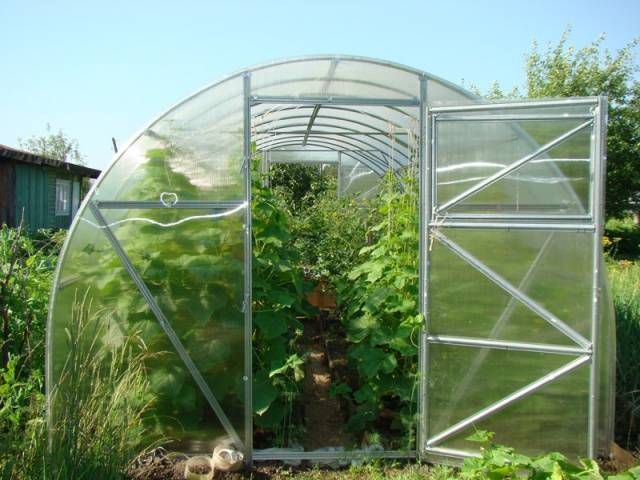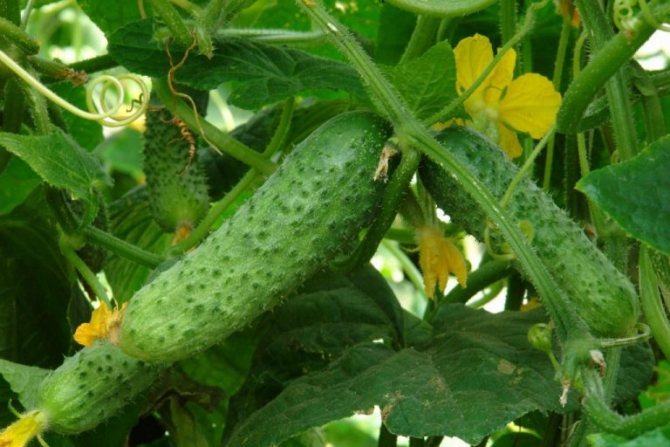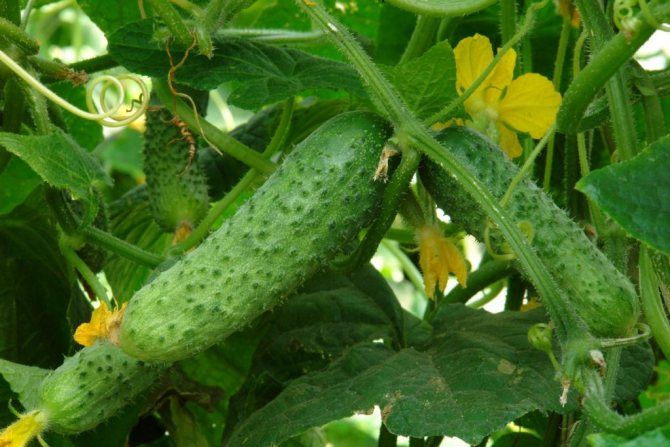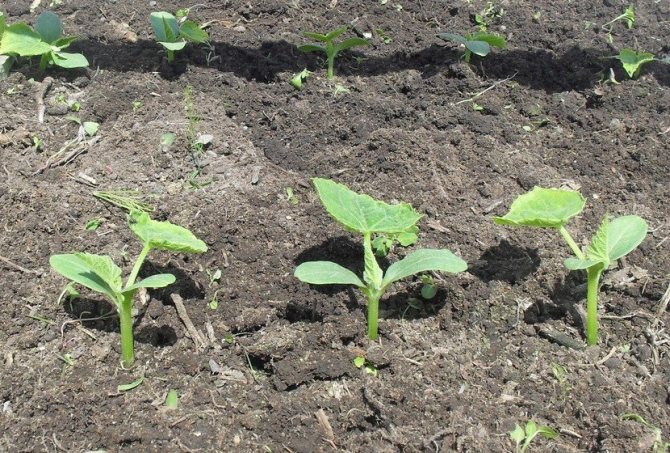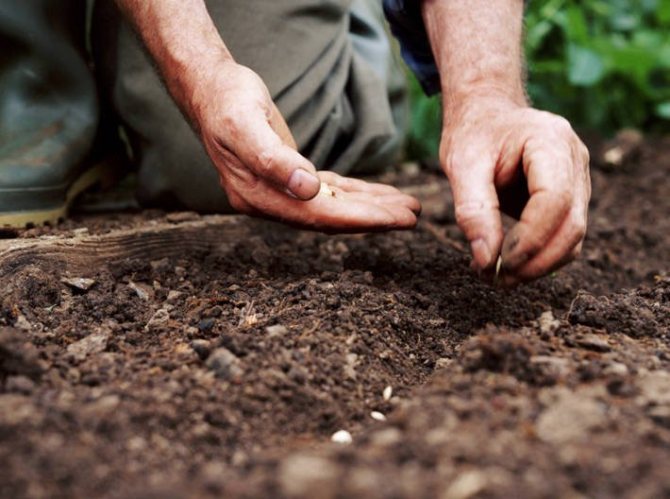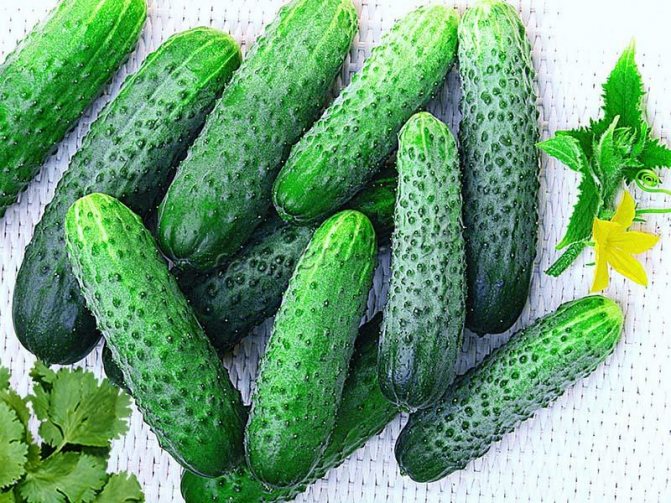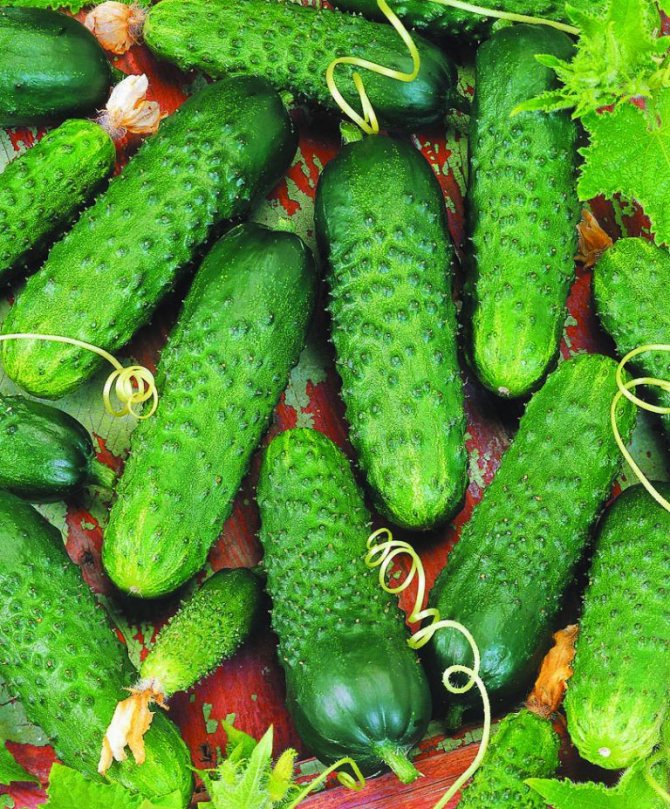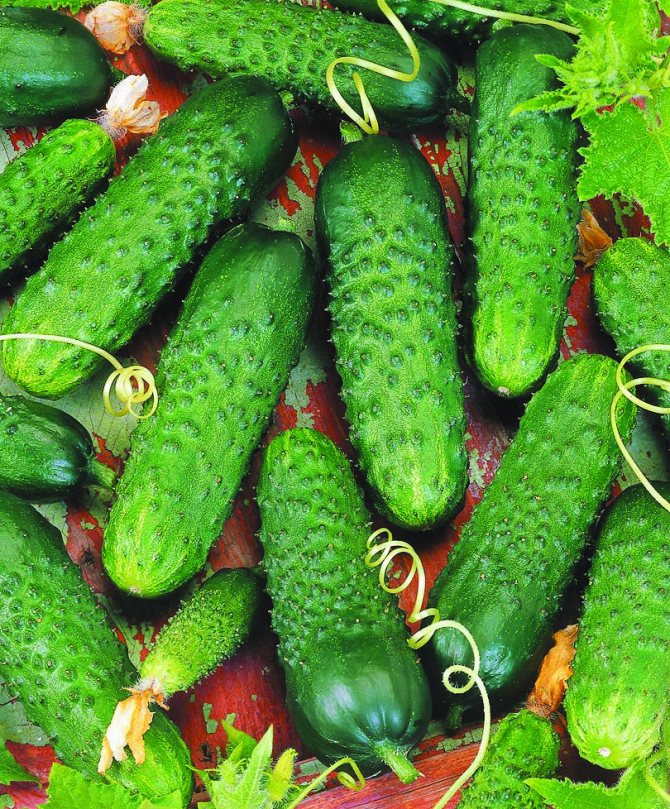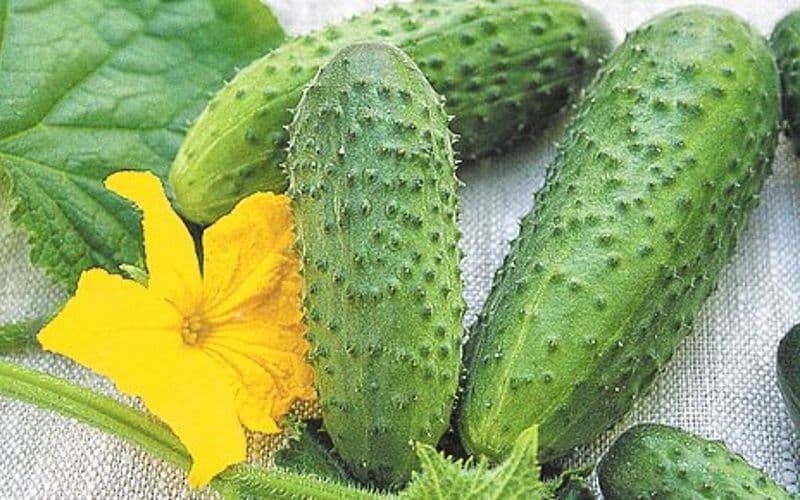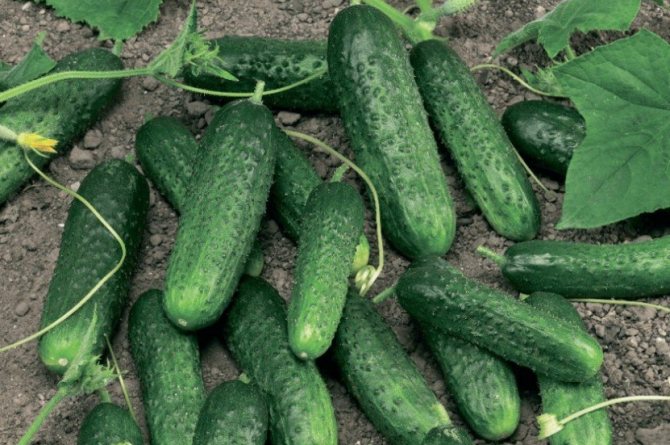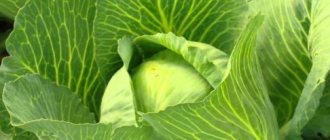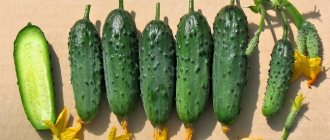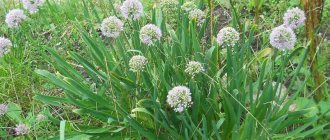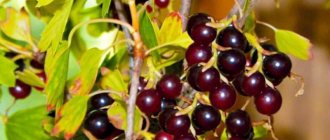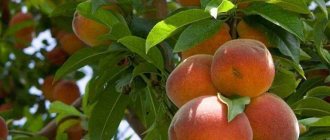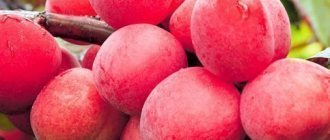Description and distinctive features of Meringue cucumbers
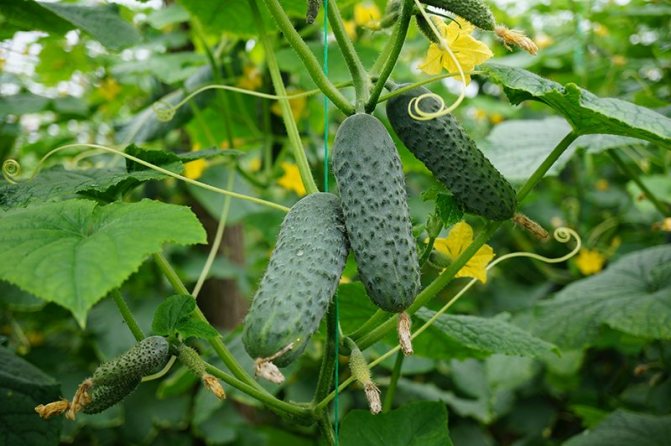
Meringue is a great variety without bitterness
Cucumbers are an annual herb with creeping stems containing leaves and fruits. Meringue F1 is a new hybrid self-pollinating variety developed by Dutch breeders. The fruit has a cylindrical shape and a rich dark green color, the color does not change during ripening. Cucumbers reach 8–10 cm in length and weigh from 80 to 100 g.
Merengi fruit tastes good. The bitterness characteristic of some varieties is absent. The vegetable contains many trace elements, vitamins A and C. Merengue cucumbers can also be used for dietary nutrition, 100 g of vegetables contains 13 calories.
Important! The fruits are distinguished by an attractive presentation, have a dense structure without voids, therefore, they are well suited for sale.
Video: characteristics of the Merenga variety
Gardeners reviews
The Merengue cucumber received excellent reviews for its resistance to many diseases and pests, good taste, and high yield. Gardeners note the ease of care and undemandingness to the composition of the soil for growing crops. In addition, the vegetable gives almost 100% seed germination for any type of planting, which is also important. The hybrid does not lose its taste even when pickling and salting, the fruits remain aromatic and crispy.
It is also noted for its endurance to long-term transportation, which is important for the sale of the crop.
Some vegetable growers say that the ripening dates do not correspond to the stated ones, but there are few of them. It is possible to purchase low-quality planting material or non-observance of the rules for planting and growing vegetables. Also, the yield depends somewhat on the climatic characteristics of the region, the method of cultivation and the weather conditions of the current season. In most cases, the Meringue cucumber meets the expectations of gardeners.
Features of planting and growing
For Meringue cucumbers, breathable medium loamy soils should be selected. The most suitable precursors for this crop are onions, potatoes, peppers, corn, peas, tomatoes or cabbage.
To improve germination, the soil must be fertilized. For every 10 sq.m. make 80-100 kg of manure, 400 g of superphosphate or 250 g of potassium salt. You do not need to use all types of fertilizers at once, you can choose one. Also note that you need to dig up the site in the fall. With the onset of spring in March or April, ammonium nitrate and ash are introduced at the rate of 200 g per 10 sq. M.
Important! It is not recommended to plant cucumbers in one area more than 1 time in 5 years. They begin to prepare the soil in the fall.
Vegetables can be grown in two ways:
- by direct sowing of seeds;
- through seedlings.
Each method has its own advantages. Direct seeding saves time and effort. Seedling method helps to speed up the collection, as well as increase yields.
Seed preparation
Sowing is started in late April or early May, when the soil warms up to + 12 ° C ... + 15 ° C. The seeds must be pre-processed. This process involves several stages:
- First, the planting material is placed near heating devices, where the temperature is at 25 ° C, and left for 30 days. This will allow you to get uniform seedlings.
- In order to disinfect, the seeds are placed for 60 minutes in an infusion of 100 ml of water and 30 g of garlic pulp. Then the planting material is wrapped in a cloth and soaked for 12 hours in a solution consisting of 1 liter of water, 1 tsp. nitrophoska and a similar amount of ash.
- After this procedure, the seeds are washed with clean water, placed in a damp cloth and left for 2 days at a temperature of 20 ° C so that they swell.
- The final stage of preparation is to place the planting material in the refrigerator for 24 hours.
Direct seeding
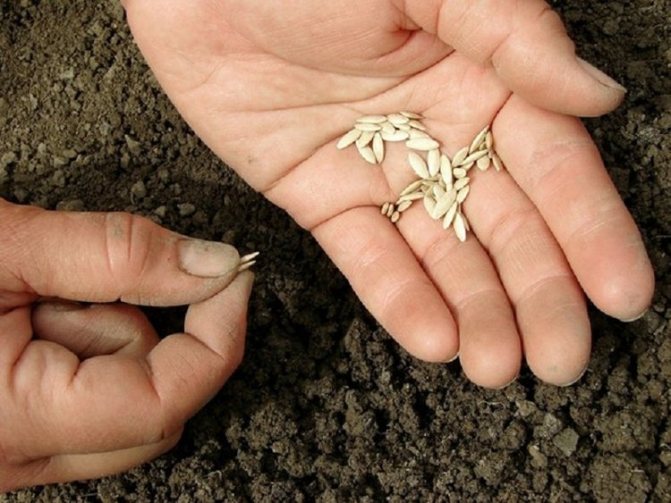

Sowing cucumber seeds in the ground
- Prepare holes 2-3 cm deep. A distance of 50-60 cm is observed between the rows.
- 3-4 units of planting material are placed in prepared holes every 7-10 cm.
- After the appearance of the first shoots, the soil is loosened. And when the leaves appear, you need to thin out the crops. 3-4 seedlings are left in each hole
At this time, the first feeding is applied. Bird droppings or mullein are diluted with water in a ratio of 1: 5 and cucumbers are watered at the rate of 10 liters of composition for 20-25 plants. After 13-15 days, re-feeding is carried out. To do this, you can use a similar solution or prepare a new composition of 10 liters of water, 15 g of ammonium nitrate and 15 g of potassium sulfate. After feeding, the plants are watered with clean water from a hose to wash off the fertilizers.
Planting seedlings
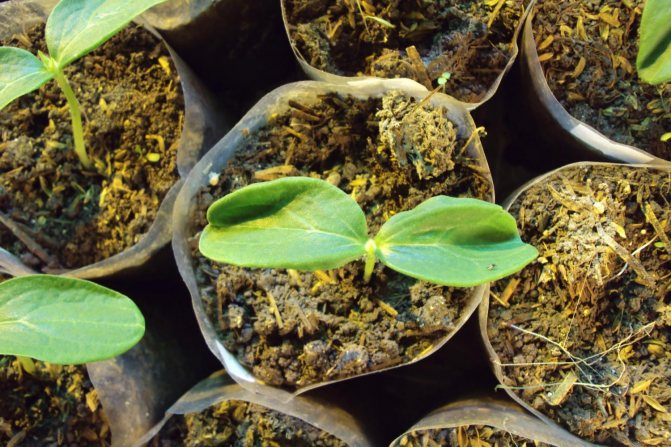

Seedlings are planted in open ground after 27-30 days
The method of growing seedlings has its own characteristics:
- First, the seeds are planted in containers 10–12 cm high. Before that, the seeds must be processed.
- For planting, a soil substrate of sawdust, peat and humus is used, mixed in a ratio of 1: 2: 2. For 10 kg of this mixture add 2 tbsp. l. ash, 1.5 tbsp. l. nitrophosphate. The substrate is filled in the containers by 2/3.
- One seed unit is planted in each pot. When 2 leaves appear on the plants, fertilizer must be applied. In 3 liters of warm water with a temperature of 20 ° C, dilute 3 tsp. nitrophoska or nitroammophoska.
- After 27-30 days, the seedlings are planted in open ground, following the same scheme that is used for direct planting of seeds. The plants need to be watered abundantly beforehand.
- After 3 days after planting, the plant is tied to a trellis.
Advantages and disadvantages of a hybrid
Check out these articles as well
- Autoclave Home Standard
- Self-fertile varieties of apricot
- Mandarin duck
- Breed of chickens Shaver Brown
Hybrid cucumbers usually have many positive qualities. Such plants are characterized by firmness and vigor of growth, but what qualities does Meringue F1 have?
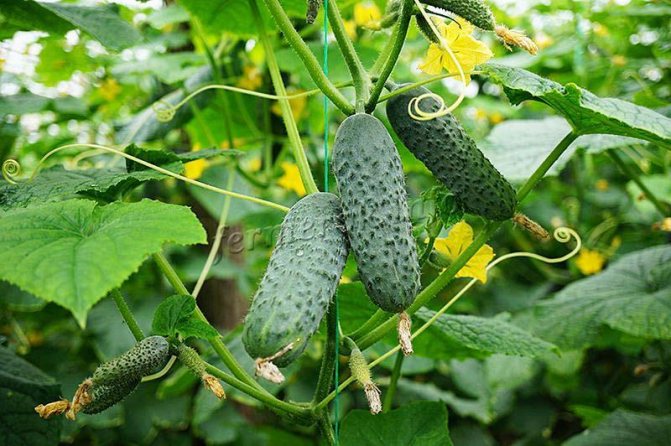

Advantages of cucumbers Meringue F1
- Early maturity. From the moment of planting the seeds to the appearance of greens, it takes 55-60 days, and when planting seedlings, only 40 days.
- Does not need pollination.
- Outdoor yield 10 kg / m. sq., and in a closed - 15 kg / m. sq.
Important!
Cucumbers Meringue F1 differ in germination within 90-100%. And yet, when choosing seeds, you should give preference to proven producers.
- Purchased hybrid seeds give stable yields. Only rare grains do not sprout, so you can confidently attribute it to reliable species that never let gardeners down.
- The commercial quality of cucumbers allows them to be grown not only for personal consumption, but also for sale.
- High transportability. They do not deteriorate during transportation and retain a pleasant appearance.
- There is a strong immunity to powdery mildew, oversporosis and some other diseases.
- Cucumbers Meringue F1 have a rich vitamin composition. They are very healthy, with high dietary qualities.
Of the shortcomings, gardeners note only one point - the need to buy seeds annually.Since this is a hybrid of the first generation (F1), the seeds of zelents are sterile and do not yield the next year. Therefore, you have to buy them every spring. But since they are not very expensive, this is an acceptable and fully justified waste.
Plant care
Watering
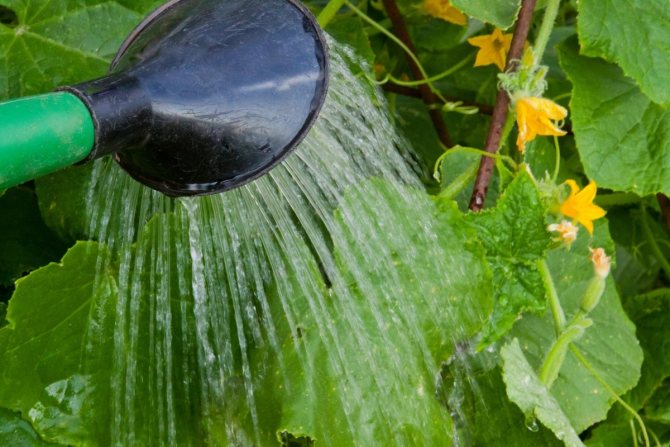

Merengue needs moderate daily watering
Cucumbers need daily watering. At each stage of development, a certain amount of water is used. Before the formation of flowers for watering 1 sq. m. 2-3 liters of liquid will be enough. The water should be warm (approximately + 26 ° C). During flowering and fruiting, the abundance of watering is increased to 3-5 liters per 1 sq. m.
Fertilizers
Every 5-7 days, the cucumbers are fed. For this, drugs that do not contain chlorine are used:
- Kristalon cucumber (1–2 g of the product are diluted in 1 liter of water, used at the rate of 250 liters of composition per 1 hectare).
- As a top dressing, you can also use a mixture prepared from 100 liters of water, 400 g of ammonium nitrate, 400 g of double superphosphate and 300 g of potassium sulfate. When all the components are completely dissolved, add 30 g of iron and 20 g each of boric acid and copper sulfate.
- A solution of 100 liters of water, 200 g of urea, 100 g of potassium sulfate and 150 g of superphosphate is also suitable. 100 sq. m. plot will require 25 liters of such feeding.
Molding
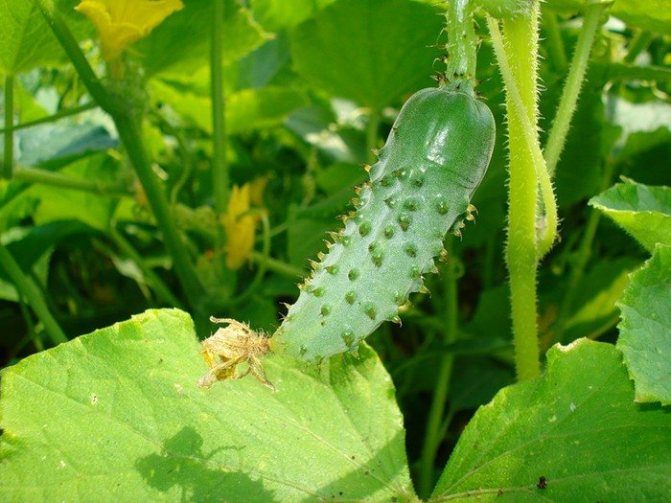

The formation of the bush allows you to increase the yield
For cucumbers to get enough light, they must be shaped correctly. In the axils of leaves up to a level of 60 cm, flowers and shoots are removed, the length of which is 2–5 cm. To a height of 1 m, one leaf and one fruit are removed from the stems.
When the main shoots outgrow the trellis, they are bent over to the wire and the tops are fixed with twine. Stems at a level from 1 to 1.5 m are pinched into 3 leaves and 2 fruits. The first shoot, which forms after the twine, is eliminated so that it does not create a shadow, the rest are passed down and pinched twice every 50 cm.


The tops of the shoots are fixed to the chalet with a twine
Features of hybrid agricultural technology
Meringue F1 hybrid is grown in various ways:
- in a greenhouse and in open-air beds;
- sowing directly on the ridges or through seedlings.
The choice is determined by climatic conditions, opportunities and desire of gardeners. Yields are higher in shelters (up to 15 kg per square meter), in addition, planting in greenhouses through seedlings allows you to get early harvests even in temperate climates.
Growing seedlings
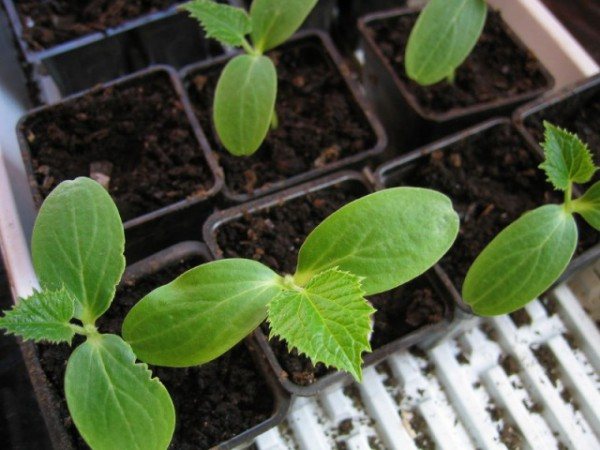

Hybrid seeds are usually sold processed and ready to plant.
On a note!
The seed is sold in sachets with added protection. The seed coat is pink, green, or blue.
Sowing dates depend on the weather characteristics of the area and the approximate time of planting seedlings in a permanent place. The seedling age should be 20-25 days, based on this, the sowing days are calculated.
Approximate sowing dates for seedlings (in the middle lane):
- for greenhouses - April 20;
- for open ground beds - the first days of May.
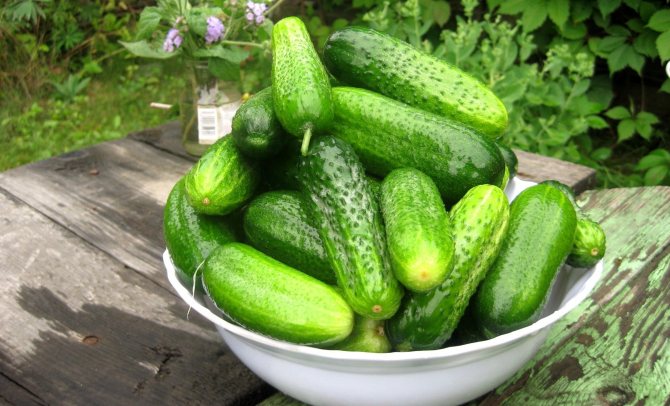

Diseases and pests
Table: common diseases varieties and treatment methods
| Diseases | Symptoms | Control methods |
| Root rot affects both seedlings and adult plants. The reason for the occurrence is the use of low-quality seeds, watering with cold water, planting in dense soil. | Dying off of roots. | Cleaning of weeds. Soil cultivation with dry bleach (200 g per 1 sq. M.). Elimination of sick cucumbers. |
| White rot develops as a result of increased humidity. | The presence of mucus on the stems, leaves and ovary. | Removal of affected plants. Soil treatment with a composition of 10 liters of water, 10 g of urea and 2 g of vitriol (1 liter of solution per 10 square meters). |
| Anthracnose occurs due to high humidity. | The formation of yellow-brown spots on the leaves, the spread of pink bloom throughout the plant. Darkening and shrinking of fruits. | Treatment of a diseased plant with a suspension of bleach 20 days before harvesting (40 g per 10 l of water). If necessary, the solution is applied again after 10 days. |
Photo gallery: common diseases
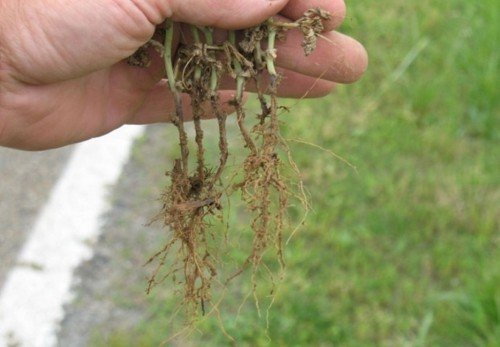

Decay of the roots of cucumbers
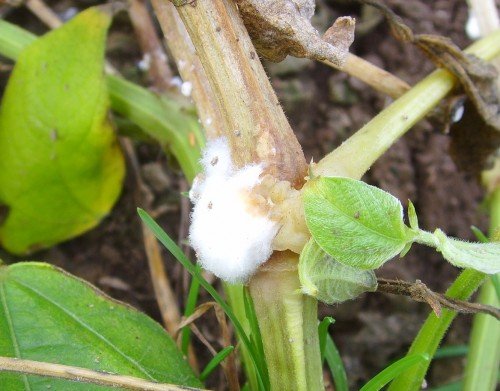

The appearance of white rot
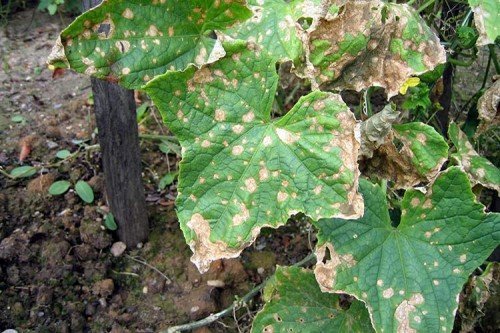

The appearance of anthracnose on foliage
Table: typical pests of the Meringue variety and control methods
| Pests | Signs | Ways to fight |
| Whitefly | The presence of larvae on the back of the leaves. | Removal of larvae with water. Planting around the perimeter of the tobacco site. Treatment of cucumbers with Inta-Vir (1 tablet per 10 liters of water). Plants can be sprayed no more than 3 times. |
| Slugs | The presence of mucus and dark droppings on the plant. Traces of eating fruit pulp. | Use of the drug Metaldehyde. In the evening, it is laid out on the site at the rate of 4 g per 1 sq. M. The drug should not be used more than 2 times. |
| Ants | The presence of many underground passages. | Placement of bottles filled with sweet syrup as a trap on a bed. |
| Spider mite | The presence of a small cobweb on the plant. | Watering normalization. Planting dill near cucumbers, which attracts ladybirds. These insects destroy spider mites. Spraying cucumbers with an infusion of 200 g of onion or garlic husks and 10 liters of water. Processing is carried out 4-5 times during the season. |
| Melon aphid | Falling leaves, wilting flowers, decreased yield. | Destruction of weeds in the garden. Spraying the culture with a solution of 50 g of crushed soap, 200 g of ash and 10 liters of water. |
Photo gallery: common parasites
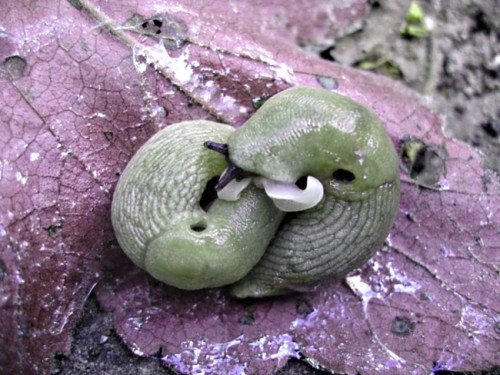

Slugs on cucumber foliage
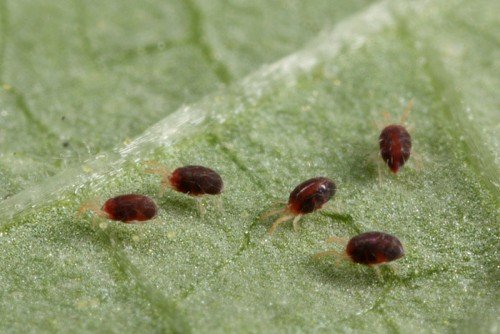

Spider mite
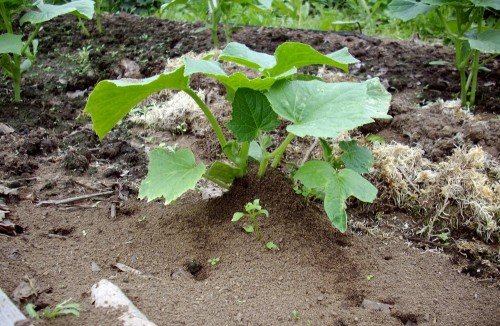

Ants harm the growth of cucumbers
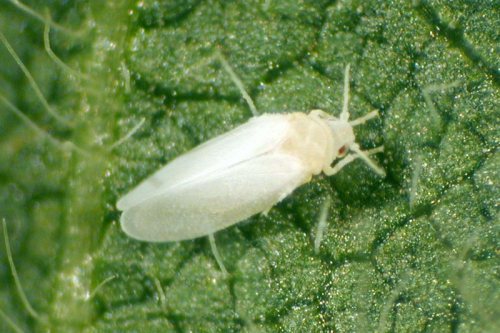

Whitefly
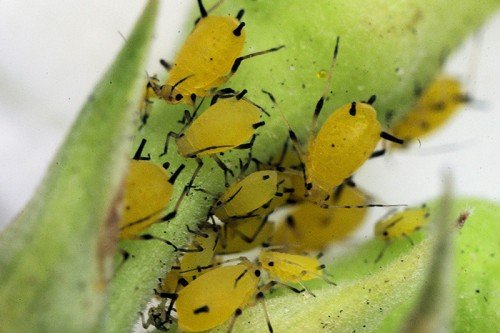

Melon aphid
Possible difficulties in growing a variety
Meringue F1 variety is resistant to most cucumber diseases: powdery mildew, cucumber mosaic virus and olive spot. But it has an average resistance to downy mildew (peronosporosis). If, nevertheless, infection has occurred, it is worth treating the plants with special agents that can be found in specialized stores (Ridomil Gold, Strobi, Quadris, etc.).
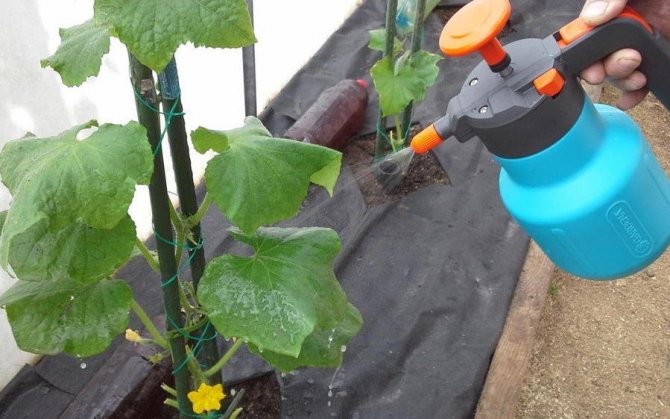

Of the pests, cucumbers are annoyed by ants, slugs, whiteflies, spider mites and melon aphids. Evidence of the appearance of pests, depending on their type, may be the falling or wilting of leaves, the presence of a thin cobweb, larvae or mucus spots.
You can learn more about whitefly control methods on cucumbers.
From aphids, plants should be treated with the following preparations: "Confidor", "Fitoverm", "Iskra-M". In the fight against spider mites, spraying with colloidal sulfur or Tiovit Jet will help. To get rid of ants, you can place containers with sweet syrup as traps near the cucumber bushes.
Harvesting
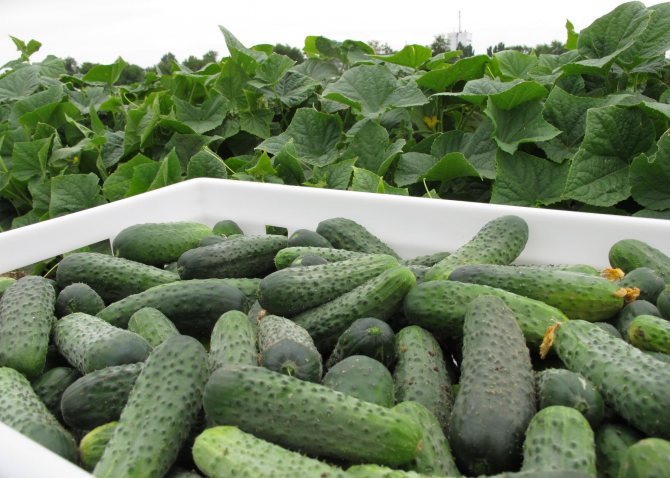

Harvesting takes place 1.5 months after planting
Merengue belongs to early ripening varieties, you can start harvesting as early as 35–45 days after planting. 6-7 fruits are obtained from one node. Cucumbers are harvested every 1-2 days with a knife. In this case, the stalk must remain on the lash, it must not be twisted and tugged.
Important! If there are spots and scratches on cucumbers, they must be removed immediately, as these damage may indicate a disease of the plant.
Fresh cucumbers are stored no longer than 1-2 weeks. To prevent the fruits from wilting during this time, they are wrapped in polyethylene. Also, for this, you can cut off the vegetables along with the stalks and place them in a jar or pan filled with water, legs down. To prevent decay, the fluid is regularly changed every 2-3 days.
Another storage method is to cover the fruit with egg white. When this kind of glaze dries up, vegetables can be kept even at room temperature. Meringue cucumbers are suitable for salads, pickling and canning.
Outdoor Grow Tips
Cucumbers "Merenga" are most often grown through seedlings.
To preserve the fragile roots, it is recommended to grow cucumbers in coconut tablets or briquettes. Plant breeders in reviews are not advised to use peat pots or tablets for growing cucumbers, as they easily lose their shape.
In order to get healthy, strong seedlings, you must follow the following rules:
- The land for cultivation should be light, free of weed seeds;
- Each plant needs to be provided with a separate container;
- It is better to plant seedlings later than overgrown plants;
- It is necessary to provide the seedlings with a sufficient amount of ultraviolet radiation, if necessary - to supplement them;
- Water gently - excess moisture can destroy the roots of cucumbers;
- Before planting in a permanent place, it is necessary to harden the seedlings.
The characteristics of the soil are of great importance. With high acidity, lime or dolomite flour must be added. It is undesirable to water the cucumbers abundantly before planting, a wet earthen lump may lose its shape, this will make it difficult to transplant cucumbers.
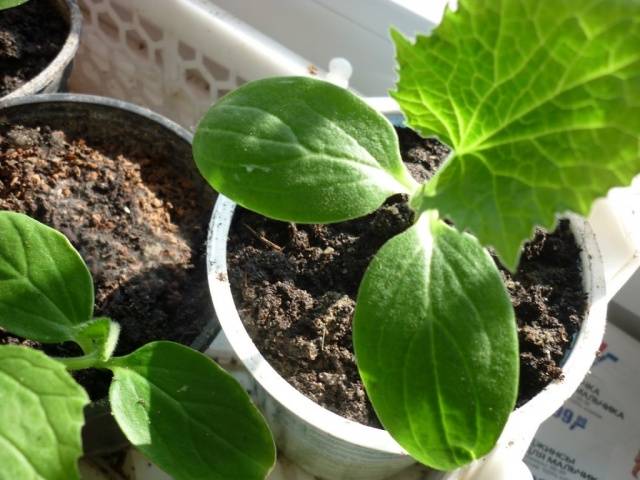

It is most convenient to use a coarse mesh stretched over trellises. The leaves of the “Merenga” variety are sparsely located, the fruits are clearly visible, so the picking of the cucumber crop is not difficult.
Cucumbers respond well to the introduction of complex fertilizers, it is desirable to use the nutrients in a chelated form. Chelated fertilizers are more easily absorbed by the root system of cucumbers, they can be effectively used for foliar dressing.
Cucumber fruits overfed with nitrogen are poorly stored and become unsuitable for canning.
It is necessary to harvest cucumbers at least once every 4 - 5 days. If you leave the greenery on the bush for longer, the bush will waste nutrients in vain, in addition, the formation of new fruits stops.
Read also: Useful properties of cloudberries and contraindications, use in traditional medicine
The cucumber continues to bear fruit until frost. If you provide shelter to the cucumber in the fall, you can significantly prolong fruiting.
